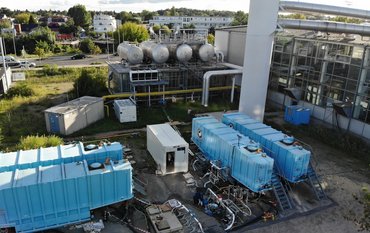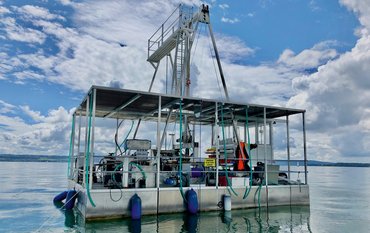Using novel reaction path modeling, it has been clarified whether the operation of pumped storage power plants affects water quality.
The simulation results of 36,380 hypothetical application scenarios show that the operation of pumped storage power plants generally has little impact on water quality in former brown coal open-pit mines. The operation therefore has only a minor influence on the pH value as well as sulfate and iron concentrations, compared to the naturally occurring geochemical processes in flooded open-pit lakes. However, before the construction of a pumped storage power plant, it is essential to check whether the natural conditions in the open-pit mine (acid buffering capacity and atmospheric oxygen input) are favorable. The two studies that have been published on this topic appeared in the scientific journals “Environmental Earth Sciences” and “Mine Water & the Environment”. The work was led by Section 3.4 Fluid System Modeling.
Storing Excess Energy
The need for energy storage is growing in Europe. The ongoing energy transition requires energy storage capacities, as surplus electrical energy is generated during electricity generation from renewable sources. There are various ways to store this energy and make it available again at a later time as needed. However, in addition to energy storage, corresponding systems and facilities are also necessary for stabilizing the power grids. Pumped hydropower storage plants in former brown coal open-pit mines can be one building block, as they offer urgently needed additional energy storage capacity. The system is based on the use of two water reservoirs located at different topographic elevations. When there is surplus solar and wind energy, water is pumped from the lower reservoir to the upper reservoir. When needed, the water is released via turbines into the lower basin, generating electricity.
This storage concept requires, in the overall system, water quality that excludes both ecological and technical impairments during long-term operation. Lignite mines that are suitable for pumped hydropower storage plants are generally located in unconsolidated sediments, which often contain the mineral pyrite. This can lead to hydrogeochemical reactions, so that substances are mobilized during the flooding of the open-pit mines, which could lead to surface water and groundwater contamination or acidification. Therefore, research into water quality is of high importance for the potential operation.
Novel Reaction Path Model: Methodological Approach and Results
Based on digital geochemical batch reactors, a new type of reaction path model was developed. This was done to estimate how strongly the water will be affected by sulfate, iron, and acidification during the flooding of an open-pit lignite mine. Three processes were considered in particular: pyrite oxidation, acid buffering, and dilution. With the reaction path model, scientists can simulate, understand, and quantify chemical reactions in the course of an overall process. In this case, pyrite oxidation, pH buffering by calcite dissolution, and the mixing of different waters in the reservoirs of the pumped storage system and adjacent groundwater aquifers were modeled.
The fact that the operation of pumped storage power plants generally has only a minor influence on the pH value as well as sulfate and iron concentrations is due to natural buffering capacities, such as calcite, dilution effects, and other site-specific factors. However, under certain conditions, such as insufficient acid buffering capacity of the subsurface or extensive oxidation of pyrite due to increased input of atmospheric oxygen, there can still be significant loads on the systems, but this is independent of pumped hydropower storage. All of this is site-dependent and must be checked before the construction of a pumped hydropower storage facility.
In a publication building on the first study, the reaction path model was applied to two sites in Greece and Poland as part of the EU-RFCS project ATLANTIS. The results confirm the previous findings: both sites are potentially suitable for pumped storage.
The results of the studies highlight the importance of early site-specific geochemical assessments, as well as proactive measures to control pyrite oxidation and maintain acid buffering capacity, in order to ensure the long-term use of buffer storage systems in flooded open-pit lignite mines.
Original Publications:
Schnepper, T., Kühn, M. & Kempka, T. Reaction Path Modeling of Water Pollution Implications of Pumped Hydropower Storage in Closed Open-pit Lignite Mines. Mine Water Environ 44, 107–121 (2025). doi.org/10.1007/s10230-025-01039-y
Schnepper, T., Kapusta, K., Strugała-Wilczek, A. et al. Potential hydrochemical impacts of pumped hydropower storage operation in two European coal regions in transition: the Szczerców-Bełchatów mining complex, Poland, and the Kardia Mine, Greece. Environ Earth Sci 84, 247 (2025). https://doi.org/10.1007/s12665-025-12198-0
Participating Institutes: Section 3.4 Fluid System Modeling | GFZ, Central Mining Institute (Poland), PGE GiEK S.A (Poland), Chemical Process and Energy Resources Institute (Greece)
Information on the ATLANTIS Project:
ATLANTIS: An interdisciplinary feasibility study on hybrid pumped-hydro power storage of excess energy in open-pit coal mines funded by the the Research Fund for Coal and Steel (RFCS) under grant agreement no. 101034022
Further explanations for the news text:
Pyrite oxidation describes the formation of sulfuric acid when pyrite reacts with atmospheric oxygen. This can lead to acidification and increased sulfate and metal concentrations.
Acid buffering refers to how well a system can neutralize acid, for example, through minerals like calcite, which also occur in the sediments of open-pit lignite mines.
Inflowing groundwater or surface water naturally leads to dilution of the water and also results in lower pollutant concentrations.
![[Translate to English:] Mine and water](/fileadmin/_processed_/7/f/csm_Figure_PHS_greece_6b657d40ec.png)





![[Translate to English:] Group photo with 8 people in a seminar room in front of a screen.](/fileadmin/_processed_/2/1/csm_20251114_News_EU-Water-Resilience-Exchange_Kreibich_c-xx_db4e5be690.jpeg)



![[Translate to English:] Portrait photo, blurry background](/fileadmin/_processed_/a/2/csm_2025_11_06_JEAN_BRAUN_HE_Helmholtz_Portraits-23_2b5c35beee.jpeg)

![[Translate to English:] Excerpt from a map of the Phlegraean Fields near Naples, Italy: Left: Red dots mark smartphone sensors, yellow triangles mark fixed seismological stations. Right: The area is coloured in shades of yellow, red and purple according to the amplification of seismic waves.](/fileadmin/_processed_/3/b/csm_20251028_PM_Smartphone-Earthquake_Slider_12500fa0e6.jpeg)

![[Translate to English:] Green background, portrait of Heidi Kreibich](/fileadmin/_processed_/1/1/csm_20251023_Kreibich-Heidi-2025-Vollformat-green_web_-c-Michael-Bahlo_72946c7fe4.jpeg)



![[Translate to English:] semicircle depicting the future missions, graphics of the new satellites](/fileadmin/_processed_/3/d/csm_2025_10_08_Copernicus_Erweiterung_3f08a76a33.png)
![[Translate to English:] Portrait picture](/fileadmin/_processed_/f/4/csm_Magnall-Joseph-Kachel-c-privat_36e23315c3.jpeg)










